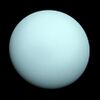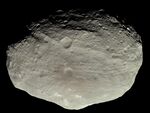Astronomy:2011 QF99
| Discovery | |
|---|---|
| Discovery site | Mauna Kea Obs. |
| Discovery date | 29 August 2011[1] (first observation only) |
| Designations | |
| 2011 QF99 | |
| Minor planet category | Uranus trojan[2] centaur[1] · distant[3] |
| Orbital characteristics[1] | |
| Epoch 4 September 2017 (JD 2458000.5) | |
| Uncertainty parameter 3 | |
| Observation arc | 3.97 yr (1,449 days) |
| |{{{apsis}}}|helion}} | 22.422 AU |
| |{{{apsis}}}|helion}} | 15.659 AU |
| 19.040 AU | |
| Eccentricity | 0.1776 |
| Orbital period | 83.08 yr (30,346 days) |
| Mean anomaly | 283.84° |
| Mean motion | 0° 0m 42.84s / day |
| Inclination | 10.833° |
| Longitude of ascending node | 222.52° |
| 288.25° | |
| Physical characteristics | |
| Mean diameter | 60 km (calculated)[2] |
| Geometric albedo | 0.05 (assumed)[2] |
| Absolute magnitude (H) | 9.6 (R-band)[2] 9.7[1] |
Asteroid 2011 QF99 is a minor planet from the outer Solar System and the first known Uranus trojan to be discovered. It measures approximately 60 kilometers (37 miles) in diameter, assuming an albedo of 0.05.[2][4] It was first observed 29 August 2011 during a deep survey of trans-Neptunian objects conducted with the Canada–France–Hawaii Telescope, but its identification as Uranian trojan was not announced until 2013.[2][5]
2011 QF99 temporarily orbits near Uranus's L4 Lagrangian point (leading Uranus). It will continue to librate around L4 for at least 70,000 years and will remain a Uranus co-orbital for up to three million years. 2011 QF99 is thus a temporary Uranus trojan—a centaur captured some time ago.[2][6]
Uranus trojans are generally expected to be unstable and none of them are thought to be of primordial origin. A simulation led to the conclusion that at any given time, 0.4% of the centaurs in the scattered population within 34 AU would be Uranus co-orbitals, of which 64% (0.256% of all centaurs) would be in horseshoe orbits, 10% (0.04%) would be quasi-satellites, and 26% (0.104%) would be trojans (evenly split between the L4 and L5 groups).[2] A second Uranian Trojan, 2014 YX49, was announced in 2017.[7]
References
- ↑ 1.0 1.1 1.2 1.3 "JPL Small-Body Database Browser: (2011 QF99)". Jet Propulsion Laboratory. https://ssd.jpl.nasa.gov/sbdb.cgi?sstr=3632683.
- ↑ 2.0 2.1 2.2 2.3 2.4 2.5 2.6 2.7 Alexandersen, M.; Gladman, B.; Greenstreet, S.; Kavelaars, J. J.; Petit, J. -M.; Gwyn, S. (2013). "A Uranian Trojan and the Frequency of Temporary Giant-Planet Co-Orbitals". Science 341 (6149): 994–997. doi:10.1126/science.1238072. PMID 23990557. Bibcode: 2013Sci...341..994A.
- ↑ "2011 QF99". Minor Planet Center. http://www.minorplanetcenter.net/db_search/show_object?object_id=2011+QF99.
- ↑ Choi, C. Q. (2013-08-29). "First 'Trojan' Asteroid Companion of Uranus Found". Space.com web site. TechMediaNetwork. http://www.space.com/22590-uranus-trojan-asteroid-discovery.html.
- ↑ Alexandersen, M.; Kavelaars, J.; Petit, J.; Gladman, B. (18 March 2013). MPEC 2013-F19: 2011 QF99. IAU. http://www.minorplanetcenter.net/mpec/K13/K13F19.html. Retrieved 3 September 2013.
- ↑ de la Fuente Marcos, Carlos; de la Fuente Marcos, Raúl (22 May 2014). "Comparative orbital evolution of transient Uranian co-orbitals: exploring the role of ephemeral multibody mean motion resonances". Monthly Notices of the Royal Astronomical Society 441 (3): 2280–2295. doi:10.1093/mnras/stu733. Bibcode: 2014MNRAS.441.2280D.
- ↑ de la Fuente Marcos, Carlos; de la Fuente Marcos, Raúl (15 May 2017). "Asteroid 2014 YX49: a large transient Trojan of Uranus". Monthly Notices of the Royal Astronomical Society 467 (2): 1561–1568. doi:10.1093/mnras/stx197. Bibcode: 2017MNRAS.467.1561D.
External links
- 2011 QF99 at the JPL Small-Body Database
 |






